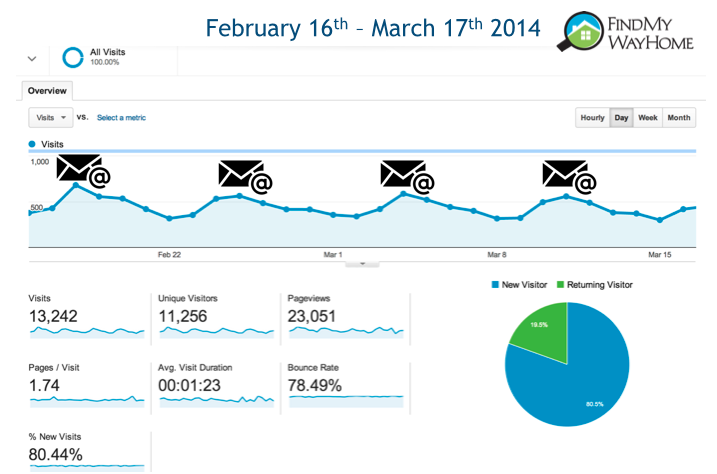 The number 1 goal of your real estate blog should be to generate customers.
The number 1 goal of your real estate blog should be to generate customers.
Not blog subscribers.
Not to see how many retweets your articles are going to get.
Let me repeat… Your number 1 goal should be to find ways to generate new customers through your content.
If you’re just getting started, below are 5 must-have ingredients for building a real estate blog and strategy that converts!
1. Good design
Design doesn’t just matter, it’s 50% of the battle. – Rand Fishkin
Good design = Trust.
You don’t need to spend thousands of dollars on a custom website right away. Companies like Agent Evolution and StudioPress make it easy to invest in a professional theme design that looks great and is user friendly.
Whatever you do, don’t skip this step. It’s critical to your success. A good design will:
- Lower your bounce rate. Good design makes your content easy to navigate. The easier it is for consumers to navigate and find the information that they’re looking for, the more likely they are to stick around longer.
- Increase conversions. Good design tells site visitors what actions you want them to take when they are on your website (register to your IDX, submit a form for a free home valuation, etc.).
- Make your site easier to navigate. The easier your site is to navigate, the more content your site visitors will consume. Make it easy to discover new (and old) content. The more people consume your content over and over again, the more likely they’ll be to want to work with you when the time is right.
2. Good IDX search
In the latest episode of Content Smarts Radio, Mortgage Broker Scott Schang and I talked about how to create content to attract site readers and keep them coming back for more. We pulled site statistics for both his website and a few other real estate websites. Here’s what we found …
On average, 25 – 27% of returning site visitors came back to the site to search homes for sale.
In the last 30 days, 2,592 people visiting an IDX long-tail search page. Of those visitors, the average time on site was :50 secs, and they visited 1.37 pages.
Then, in the last 30 days, 489 people visited an IDX price range page. The average time-on-site was 3:41 sec’s and they visited 4.11 pages.
Don’t just install an IDX system on your website and call it a day. Find creative ways to emphasize homes for sale on your website. Build IDX-rich community landing pages. Then, setup listing e-Alerts for anyone who register with a valid email address in order to keep them coming back to your website again and again.
3. Cornerstone content
Cornerstone content is the content that you create that will serve as the foundation of your website. Great cornerstone content helps you in the following ways:
- It’s helps you attract new readers. A post that talks about “why now is a good time to buy” isn’t all that effective. But building a landing page for a community that talks about the history of the community, the unique characteristics of that community, things to do in that community, the best schools in that community, and that shares all of the latest market statistics … is a great way to attract a local audience that’s interested in learning more about that community. (Here’s a great example of a well designed community landing page).
- It demonstrates your authority of the local market. When you take the time to write highly relevant, educational content about the community, about the buying process, about the latest market trends … potential customers will pay attention.
How To Create Great Cornerstone Content
Start by putting yourself in your customers shoes …
- What types of questions are they asking about the buying/selling process? Could you take one of these questions (or several) and write a blog post or series that talks about the buying/selling process in detail? Here’s an excellent example of a well designed “Buyers” page from M Squared Realty.
- Think back to when you bought or sold your first home. What questions did you have? What information did you struggle to find?
- What do people want to know/learn about the local community? Things to do? Best schools in the area? The latest market statistics?
Once you have a list of ideas to write about, it’s time to get writing. Make sure you …
- Use sub-headlines and bullet points to make your content easy to scan. Remember, readers like to scan. Make your post easy to read and easy to scan so that they can find the specific information that they’re looking for.
- Add images to enhance your content. If possible, since this is a real estate blog, try and take your own photos. Don’t use stock images. For your community pages, it’s easy to snap a picture that represents the local community. Adding images to break up your content helps set the tone for the rest of the content on the page.
- Don’t forget to add a Call To Action! Don’t waste an opportunity to get your readers to take action. You can use your sidebar to direct readers to your IDX search page. Or, if they’re reading your “Sellers” information page, you might drive them to your page to request a free CMA. Never waste an opportunity to encourage your readers to subscribe, register, or submit a form request for more info.
Landing pages (or Cornerstone Pages) are where you make your readers (potential home owners and home sellers) an offer and ask them to take action. Whether it’s:
- Download your free buyers report.
- Download your free sellers report.
- Visit your IDX search page to search homes for sale.
- Fill out a form to request a free CMA.
- Sign up by email to get the latest market report and statistics.
4. Email opt-in
Ask for the email early and often.
The goal of your real estate blog should be to engage with as many site visitors as possible in conversations about buying and selling real estate. One way to make sure that happens is to consistently ask for the email … by offering them a free report, asking them to register to get listing updates by email, etc.
Here are 4 compelling offers to get someone to opt-in via email:
1. Free Home Valuation
M Squared Real Estate incentivizes their free CMA report by offering a free 21-page marketing plan. Not only do you get a free, detailed CMA, you also get a step-by-step plan on preparing your home for sale.
“Free” isn’t enough of an offer to get someone to opt-in with their address and contact information. Be creative and find ways to incentivize your offer the way M Squared Real Estate did.
2. Market Reports
The Real FX Group offers free local downloadable market reports delivered once or monthly. If you want to keep an eye on how the market is doing (and plenty of people do), here you go.
Offering site visitors your professional insight on the state of the current local market is a great way to start a conversation.
3. IDX Listings
IDX listing alerts are a great way to keep people engaged and coming back to your website. Not everyone is going to buy right now. Still, keep sending them listings. 3 – 6 months down the line they might see a price reduction on one of the properties they favorited and they might be interested enough to make an offer.
Always look for ways to get your site visitors to register to save home searches. Then, set up searches for them. Talk to them about the market. Talk to them about the community. Remember, you’re cultivating leads over the long-term. If you keep nurturing your system your leads will start to convert in the long term.
4. Neighborhood Guide
Ryan Erisman, author of the Villages Florida Book, has a 184-page ebook he offers site visitors interested in buying a home in the Villages. In this case, Ryan offers this ebook as a purchase download. Whether you decide to offer it for free or paid, either way it’s a great downloadable resource and a great way to drive email opt-ins for your hyperlocal website.
What other strategies are you implementing to get site visitors to opt-in to your site via email?
5. Promotion
Nobody’s going to read your blog unless there’s something in it for them. – Seth Godin
Content is a great way to build an audience. But if you build it, they won’t always come. You have to tell people about it. You have to HUSTLE to get your stuff out there.
What you need is a promotion strategy. When you hit publish on your new post(s), don’t forget to publish them to your network (Facebook, Twitter, Google+, EMAIL).
Scott Schang publishes a newsletter once a week recapping everything he’s written about on the blog. Here’s a screenshot of his traffic stats every time he sends out that email newsletter:

Follow these steps and your on your way…
Building a high converting real estate blog takes time and effort. But if you follow these steps you’re well on your way…


Ricardo, thanks for the coaching on blogging for realtors. Many good points and all well-taken.
2 questions:
1. You said: “Not blog subscribers.
Not to see how many retweets your articles are going to get.” So, should we just not even have the features of social sharing widgets and RSS subscribe on/around our site/blog at all? or are you merely emphasizing the importance of good content with clean design. How far do we need to take the “less is more” mentality?
2. I have read that a good bounce rate is thought to be typically about 50% or less. What is your experience with real estate IDX sites? What do you consider a good bounce rate benchmark for our industry? I always think about mobile users (my site has about 10-20% higher bounce rate for mobile) and I wonder if a. it’s because my mobile responsiveness isn’t getting it or if b. mobile users behavior- they are out looking at houses, see an address and look up one specific address for details, come to my site, get the details and their gone. If b. were the case, do you have any solutions for capturing these type of visitors attention? I have recently started a retargeting ad campaign which I suppose would be good for these type of visitors but I can’t imagine that my retargeting ads are showing up on mobile.
Thanks,
Sasha
Sasha: Great questions!
With respect to social sharing counts and blog subscriber counts, it’s all about social proof and the image it creates. On real estate blogs, people simply aren’t going to share an article that talks about the latest market statistics and their not going to register for “blog updates” by the hundreds. As a consumer, it’s personal information that we’re reading and absorbing, not necessarily something we’re going to share through our social networks.
So if it were me, I’d put less emphasis on things like “Like Us on Facebook” and put more emphasis on things like “Register to Search Homes for Sale.”
Does that make sense?
Regarding bounce rates, great questions as well! With regards to mobile, do you have a mobile-IDX search enabled for your website? If so, make sure you have Google Analytics installed so that you can measure IDX usage on mobile. When I was at DS, IDX usage on mobile always spiked on the weekends. I can’t imagine users wanting to read blog content on their mobile, but I can certainly imagine them wanting to look at properties on the go!
As for “good bounce rate.” Scott Schang and I are hosting a webinar on this tomorrow… Talking about IDX landing pages and searches by price range. The searches by price range are a great way to grab a site visitors attention and keep them engaged. Ultimately, creating IDX-rich community landing pages are a more effective way to capture interest and keep people looking at more of your content. When you take the time to build those out well, you’ve won.
Hope that helps! And thanks for the comment!
Thanks Ricardo,
That all makes perfect sense. Will this webinar be available anywhere online for replay afterward?
You can register free for the webinar, it’s Friday at 11am Pacific. However the replay and downloads are only available to registered members (it’s $25 per month or $248 per year).
Here’s the link to the webinar:
http://blog.contentsmarts.co/content-strategies-webinar/
For me the hardest part is getting an email from someone and having them stick around. I know I have a lot to offer its just hard doing it right.
Hi Gary,
I took a look at your site… I think you’re doing the right things by offering downloadable guides that offer more insight into procedures. I’ve suffered a few running injuries in the last year. So for me, as a consumer, I do like to read and download material that gives me insight into things that are affecting me.
That’s the “sticking” point. Getting someone to opt-in, then slowly nurturing that relationship over time.
Thanks for advice, will try and implement it.